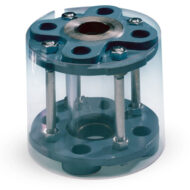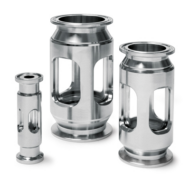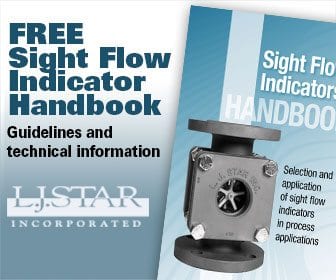Sight Flow Indicators
Product Categories
How to Choose the Right Sight Flow Indicator
Online Selection Guide
Sight Flow Indicators
There are many considerations for selecting the ideal sight flow indicator. This online guide walks you through the steps
View Through vs. Full View
A view-through flow indicator has two opposing windows so that an operator can see the intervening flow of fluid lighted from behind. This design is suited for ANSI pressure classes, high temperature, and harsh fluid applications.
Also called 360° view, a full view flow indicator passes fluid through a glass cylinder that is visible from all angles. It is ideal for the observation of process fluid for clarity, color, foam, and other conditions, and for the presence of moisture. Depending on the model it may or may not be suited for high temperatures or pressures.
Type of Indication
Rotary, flapper, flutter, ball, or drip Indicators are available that can help you easily gauge the direction and speed of flow of the process material. Indicators are particularly helpful with colorless gases and opaque fluids.
Mounting Type
The most common mounting methods are flange, threaded, and sanitary clamp. Sanitary clamp mounting is typically used in bio-pharma as well as food & beverage applications. Other options for mounting include orbital weld, Swagelok TS, union, bevel seat, I-line or other specialty connections.
Carbon Steel vs. Stainless Steel
Carbon steel is generally used for industrial applications. Stainless steel offers better corrosion resistance and is standard for pharmaceutical, food & beverage applications.
Gaskets
This doesn’t really affect the selection, as all sight flow indicators are available with a wide variety of gaskets. Just be sure that the gasket material selected is compatible with your process media and temperature requirements.
Type of Glass
Most of our sight flow indicators are available with windows made of either standard soda lime glass (for temperatures below 300◦ F) or borosilicate glass (for temperatures between 300–500◦ F.)
Borosilicate glass is more resistant to thermal shock and caustic than soda lime glass and should be specified in areas where hot equipment may experience washdowns with cool water or corrosive chemicals.
Quartz or sapphire glass is recommended for temperatures greater than 500◦ F, such as in high-temperature steam applications.
Glass can come as a conventional glass disc or as a glass disc fused to a metal ring during manufacturing. Fused sight glass windows, such as our METAGLAS® and MetaClamp® brands, hold the glass in concentric compression that makes the glass resistant to bending stresses that would otherwise cause cracks or failure. They are preferred when high-pressure ratings, impact resistance, thermal shock resistance, and high safety margins are desired.
Sterile Visual Flow Indicator Minimizes Contamination
Want to know more?
Handy 13-page engineering handbook covers sight flow indicators in chemical and pharmaceutical applications. A handy reference for experienced engineers and a useful guide for those new to sight flow indicators, it offers a full overview covering design, materials, types of indication, types of glass, accessories, plus installation and maintenance tips.


